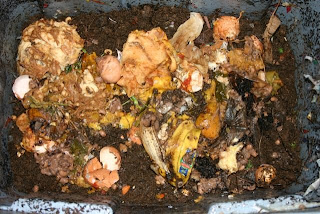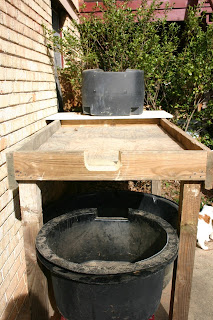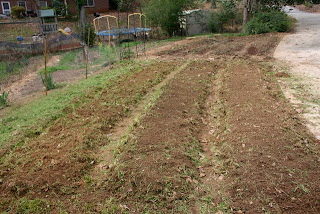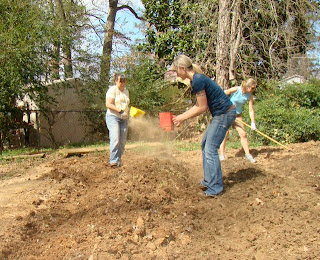




Setting up a worm bin in your home is a great way to keep organic waste out of the landfill and turn it into something useful. Worms will eat almost anything organic including paper, cardboard, kitchen scraps, and leaves. Their requirements are simple; air, moisture, food and darkness. You can make a bin out of buckets, totes, trash cans. We used a tote because we had one. You can get plastic buckets from a local restaurant or donut shop. We recommend reusing a container rather than going to a store and buying something new. The main requirement is that it is opaque because worms do not like light.
To provide air for the worms you need to drill 1/8" holes in the sides and top of the container. I put 2 rows on the sides about 3 inches apart. One row near the top and one row near the bottom. I drilled about 20 holes in the top. The bin also needs some 1/4" holes in the bottom for drainage to keep any liquid from building up which will rot the bedding. I placed a layer of landscape fabric over the holes in the bottom to keep anything other than liquid from coming out the holes.
Next you need to add about 3" of moist bedding. You can use shredded paper or shredded leaves. Soak the bedding in water and wring it out so only a few drops continue to drip out. It should feel like a damp sponge. Put the bedding in the bin and fluff it up so there is plenty of air. Next add some soil, from the ground not potting soil. About a quart will do. The soil contains microorganisms that break down the food into tiny particles the worms can ingest. They have really tiny mouths! They also get some grit from the soil which helps them to grind up the food.
Next add worms. You will need a pound of worms. We get ours from
Bear Creek Worm Farm. Their number is (678) 794 6664. They will come with a pound of bedding. Dump them gently into the bin and spread them evenly over the surface of the bedding.
Next add some food. We keep a rot bucket under the sink into which we put our kitchen scraps, paper towels, napkins, coffee grounds and tea leaves. It takes us about a week to fill it up. During that time mocroorganisms are starting to break down the stuff on the bottom so that when it goes into the bin some of it is ready for the worms to eat. When you first start your bin put only a few handfuls in so that the worms are not overwhelmed while they are getting adjusted to their new home.
Cover the food and worms with another layer of moist bedding. Keeping the food covered will discourage fruit flies. When you add additional food it is a good idea to bury it in the bedding to keep fruit flies from finding it. In a week you can start to add more food. The important thing is not to add so much wet goopy stuff that air is prevented from getting down to the worms. They are voracious eaters so the food will disappear pretty quickly.
We recently got 10 pounds of worms for the members of our workshop to start their own bins. We put them into the tote and put the top on and went to bed. The next morning Robin came screaming into the bedroom. All the worms escaped she said! I went out to the screen porch and there were thousands of worms crawling in every direction. It took me 3 hours to pick all those suckers up and return them to the bin.
To prevent this, for the first couple of nights, keep a light on. Worms do not like light and will burrow down into the bedding to get away from it. As an additional precaution spread a 2" wide band of dish washing liquid (organic of course) around the inside top of the bin. The worms will not crawl over it. Once they get over the trauma of traveling and settle into their new home they will not try to escape.
What not to feed them: Animal fat, meat scraps, cheese. You can put citrus but not a whole lot at a time. Same with onions. They both have compounds that are toxic to worms in large amounts. You can put egg shells in but crush them up finely. They really like fruit like banana peels, mango skins, anything sweet and mushy. One of my students said she cuts her banana peels into tiny pieces and the worms devour them. They like coffee grounds too but again not too much because they are very acidic.
Once the bin is filled up almost to the top you can harvest the worms and move them to a new bin. The remaining worm castings are great for feeding your vegetable garden or house plants. I will explain how to get the worms out of the bin in another post.
Become a worm wrangler. You'll love it.































